
The JLG Boom Lift Operator’s Manual is a comprehensive guide ensuring safe, efficient, and proper operation of the equipment. It covers essential safety protocols, operational procedures, and maintenance tips.
Overview of the Manual’s Purpose and Importance
The JLG Boom Lift Operator’s Manual serves as a critical resource for ensuring the safe and effective operation of JLG boom lifts. Its primary purpose is to provide operators with detailed guidelines for proper equipment usage, pre-operation inspections, and maintenance procedures.
This manual is essential for promoting workplace safety by outlining potential hazards and offering solutions to mitigate risks. It also helps operators understand the equipment’s capabilities and limitations, ensuring efficient performance.
By adhering to the manual, operators can extend the lifespan of the boom lift and prevent costly repairs. It acts as a troubleshooting guide and a compliance reference, making it indispensable for both new and experienced operators.
Ultimately, the manual is designed to empower users with the knowledge needed to operate JLG boom lifts confidently and responsibly.
Key Features of the JLG Boom Lift
The JLG Boom Lift is renowned for its advanced engineering and user-friendly design, offering exceptional performance and versatility.
It features a robust hydraulic system, ensuring smooth and precise boom movements, while its stability mechanisms provide maximum safety during operation.
The lift is equipped with intuitive controls, allowing operators to maneuver with ease, even in challenging environments.
Additionally, JLG Boom Lifts are designed with durability in mind, incorporating high-quality materials and components for long-term reliability.
Optional features such as extended reach capabilities and variable speed settings further enhance its functionality, making it suitable for a wide range of applications.
With models like the 1500AJP offering impressive height and reach capacities, the JLG Boom Lift is a trusted choice for industries requiring efficient and dependable aerial access solutions.
Target Audience for the Manual
The JLG Boom Lift Operator’s Manual is designed for individuals directly involved in the operation, maintenance, and supervision of JLG Boom Lift equipment.
This includes operators who require detailed guidance on safe and efficient use, as well as maintenance personnel needing technical specifications and troubleshooting procedures.
Supervisors and safety officers will also benefit from the manual’s emphasis on compliance with safety standards and operational best practices.
Additionally, the manual serves as a valuable resource for training programs, ensuring new operators understand proper techniques and safety protocols.
By addressing the needs of these key groups, the manual promotes overall equipment performance, workplace safety, and operational excellence.
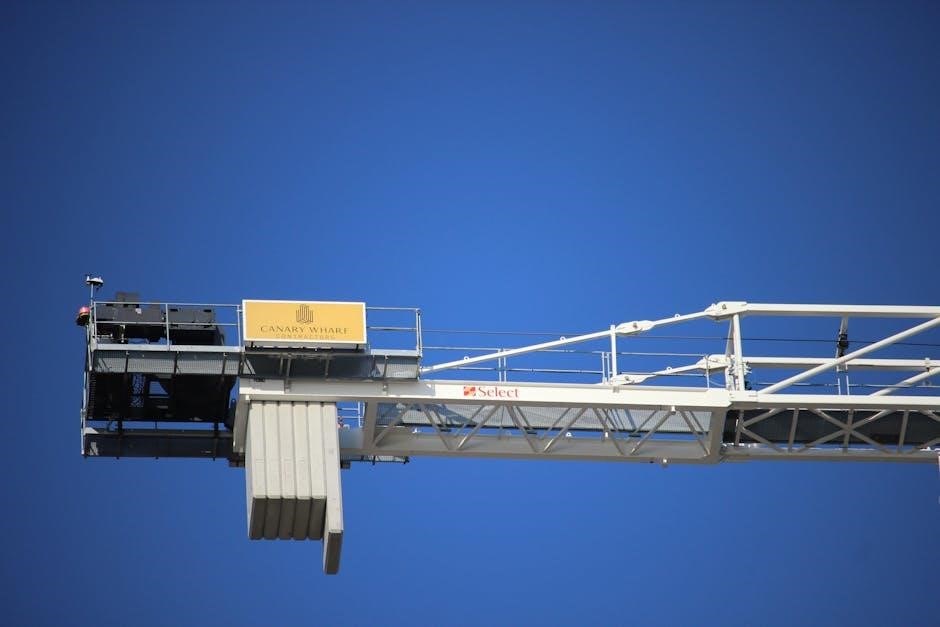
Safety Guidelines for Boom Lift Operation
Always wear fall protection and ensure the lift is on firm, level ground. Familiarize yourself with the manual and follow load limits to prevent accidents. Regular inspections are essential.
General Safety Precautions
Always wear approved fall protection when operating the boom lift. Ensure the machine is on firm, level ground and never exceed the load capacity. Conduct daily inspections of wire ropes, hydraulic lines, and control functions. Avoid operating in bad weather or near overhead obstacles. Use proper handholds and steps when entering or exiting the platform. Never lean over guardrails or overreach while working. Ensure all safety decals and warnings are legible and adhered to. Familiarize yourself with emergency procedures before operation. Keep loose clothing and long hair tied back to avoid entanglement. Maintain three points of contact with the machine at all times. Follow all manufacturer guidelines and safety standards outlined in the manual to minimize risks and ensure safe operation.
Specific Safety Checks Before Operation
Before operating the JLG boom lift, perform a thorough inspection to ensure all systems are functioning properly. Check the hydraulic system for any signs of leaks or damage. Inspect wire ropes for fraying, kinking, or wear. Verify that tires are properly inflated and that all brakes are in good working condition. Test all control functions, including boom extension, elevation, and rotation, to ensure smooth operation. Ensure the platform floor is clear of debris and that all safety gates are securely closed. Check the battery for proper charge and connections. Inspect the emergency stop and alarm systems to confirm they are operational. Review the operator’s manual for any specific pre-operation checks tailored to your model. Address any issues before use to prevent accidents. Always ensure compliance with manufacturer guidelines to maintain safety.
Operating in Hazardous Environments
When operating a JLG boom lift in hazardous environments, such as areas with explosive atmospheres, extreme temperatures, or uneven terrain, extra precautions are essential. Ensure the equipment is rated for the specific conditions. Use explosion-proof components in explosive environments and protect the machine from dust or chemicals. Check for any damage to wires or hydraulic lines that could be exacerbated by harsh conditions. Ensure proper stabilization on uneven surfaces using outriggers or levelers. Always wear appropriate personal protective equipment (PPE) tailored to the environment. Follow manufacturer guidelines for operating in extreme temperatures, as this may affect hydraulic fluid viscosity or battery performance. Regularly inspect the machine post-operation to identify and address any damage caused by environmental factors. Adhere to all safety protocols to minimize risks in challenging conditions.
Emergency Procedures and Protocols
In case of emergencies, such as equipment malfunction, accidents, or system failures, follow established protocols to ensure safety. If the boom lift experiences a hydraulic or mechanical failure, immediately stop operation and stabilize the machine. Operators should remain calm and assess the situation. If evacuation is necessary, ensure all personnel are safely removed from the platform. Notify supervisors or emergency services promptly. For incidents involving collisions or damage, document the event and report it to the appropriate authorities. Regular inspections and adherence to safety guidelines can help prevent emergencies; Always refer to the JLG manual for specific emergency response procedures tailored to the equipment. Proper training and familiarity with these protocols are critical to minimizing risks and ensuring a safe outcome in critical situations.
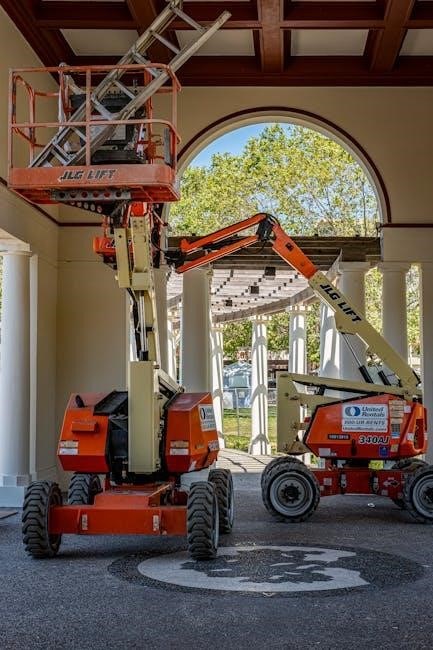
Pre-Operation Checks and Inspections
Pre-operation checks involve inspecting the boom, platform, and controls, checking hydraulic fluid levels, ensuring safety devices function correctly, and reviewing the inspection checklist daily.
Daily Inspection Checklist
A daily inspection checklist ensures the JLG boom lift is safe and ready for operation. Operators should inspect the boom, platform, and controls for damage or wear. Check hydraulic fluid levels, battery charge, and tire pressure. Verify that all safety devices, such as alarms and emergency stops, are functioning properly. Ensure proper operation of the lift and drive systems. Review the manual for specific pre-use checks tailored to the model. Document any issues and address them before use. Regular inspections prevent accidents and extend equipment lifespan. Always refer to the operator’s manual for detailed procedures and guidelines. Consistent adherence to the checklist ensures compliance with safety standards and optimal equipment performance.
Function Tests Before Use
Function tests are critical to ensure the JLG boom lift operates correctly before use. Start by testing the lift and drive systems to confirm smooth operation. Check hydraulic functions, including extension, retraction, and stabilization. Test all controls, such as joysticks and toggle switches, for responsiveness. Verify that emergency stop systems engage properly and release without issues. Ensure the platform leveling feature works accurately. Check the horn and warning alarms to ensure they function as intended. Perform a test drive to assess maneuverability and braking efficiency. Refer to the operator’s manual for specific test procedures tailored to your model. These tests help identify potential issues early, ensuring safe and reliable operation. Regular function testing complements daily inspections and supports overall equipment performance. Always document test results for maintenance records.

Hydraulic System Inspection
The hydraulic system inspection is a vital step to ensure the JLG boom lift operates safely and efficiently. Begin by visually inspecting all hydraulic hoses, fittings, and cylinders for signs of leaks, damage, or wear. Check the hydraulic fluid level and ensure it meets the manufacturer’s recommendations. Look for any signs of contamination in the fluid, as this can lead to system failure. Inspect the hydraulic pumps, motors, and valves for proper function and alignment. Test the hydraulic pressure using the specified tools to confirm it matches the levels outlined in the manual. Ensure all hydraulic components are securely fastened and free from corrosion. Refer to the operator’s manual for model-specific inspection procedures. Neglecting hydraulic inspections can lead to equipment failure, posing safety risks and increasing maintenance costs. Always follow safety guidelines and use appropriate protective gear during inspections. If issues are identified, address them promptly or consult a certified technician. Regular hydraulic system checks are essential for preventing downtime and ensuring reliable performance.
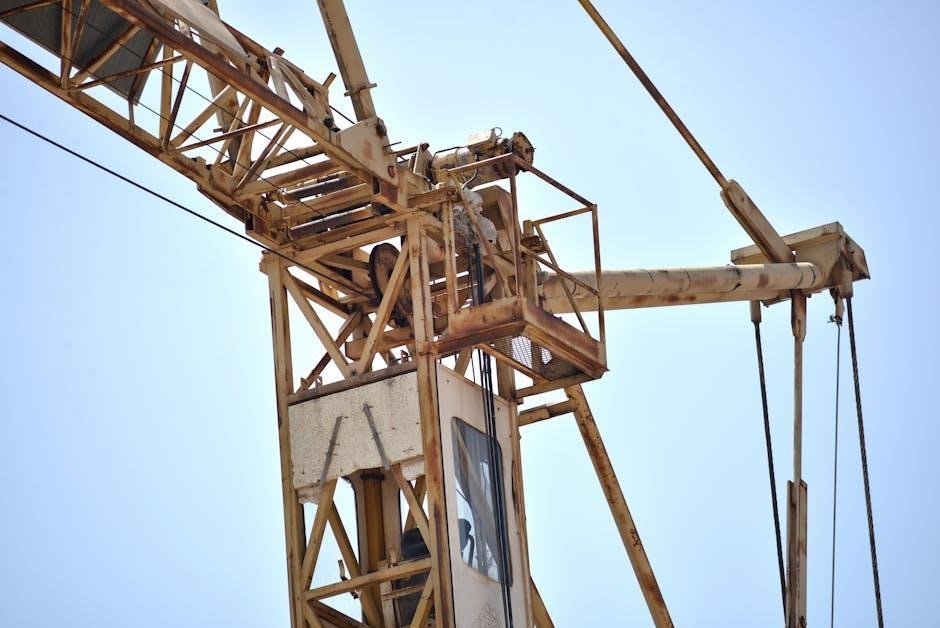
Operating Techniques and Best Practices
The JLG Boom Lift Operators Manual emphasizes smooth, controlled movements, continuous load monitoring, and stability checks. Always operate within specified weight limits and environmental conditions. Adhere to safety guidelines to ensure efficient and secure lifting operations.
Basic Operating Procedures
Understanding the JLG Boom Lift Operator’s Manual is crucial for safe and effective operation. Always begin by thoroughly reading the manual to familiarize yourself with the equipment’s features and controls. Pre-operation checks are essential to ensure all functions are working correctly. Start operations with the boom in its fully retracted position and ensure the lift is on level ground.
Operators should maintain smooth, controlled movements, avoiding sudden jerks or rapid adjustments. Always use hand signals or clear communication when working with others. Load management is critical; never exceed the specified weight limits.
Regularly monitor the surroundings for obstacles or hazards and ensure proper visibility. If unsure about any procedure, consult the manual or seek guidance from a certified professional. Proper shutdown procedures should be followed to secure the equipment safely.
Advanced Maneuvering Techniques
Mastering advanced maneuvering techniques with a JLG Boom Lift enhances operational efficiency and safety. Operators should practice precision movements, such as gradual boom extension and retraction, to maintain stability.
When navigating tight spaces, use the equipment’s tilt and rotational features carefully. Always ensure the lift is balanced and within load limits during complex maneuvers.
Operators can utilize joystick controls for smooth, precise adjustments. Practicing these techniques in controlled environments helps build confidence and skill.
Additionally, operators should be aware of their surroundings, using cameras and sensors if available, to avoid collisions. Advanced techniques require consistent practice and adherence to safety guidelines.
Load Management and Stability
Proper load management and stability are critical for safe and efficient JLG Boom Lift operation. Always adhere to the specified weight and load limits to prevent instability.
Ensure the load is evenly distributed and securely fastened to avoid shifting during operation. Operators must maintain awareness of the equipment’s balance, especially at heights or on uneven terrain.
Before lifting, check the ground conditions and ensure the lift is on a stable, level surface. Avoid sudden movements, as they can compromise stability.
In case of uneven loads, adjust the boom angle carefully to redistribute weight. Regular inspections of wire ropes, chains, and hydraulic systems are essential to maintain reliability.
Never exceed the maximum rated capacity, as this can lead to equipment failure or tipping hazards. Continuous monitoring and adjustments are necessary to ensure optimal stability during operation.
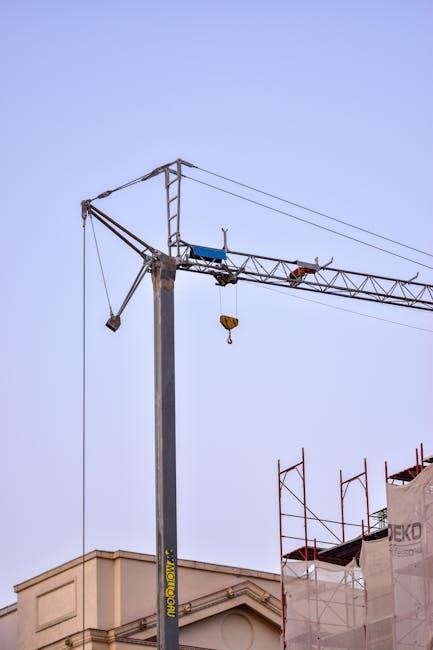
Maintenance and Troubleshooting
Regular maintenance ensures optimal performance and safety of the JLG Boom Lift. Operators should inspect hydraulic systems, wire ropes, and lubricate moving parts routinely. Troubleshooting common issues promptly prevents downtime.
Routine Maintenance Tasks
Regular maintenance is crucial to ensure the JLG Boom Lift operates safely and efficiently. Operators should perform daily checks, including inspecting hydraulic fluid levels, tire pressure, and wire ropes for wear. Weekly tasks include lubricating moving parts and checking the hydraulic system for leaks. Monthly, the boom and lift cylinders should be inspected for proper function. Annual maintenance involves detailed examination of wire ropes, hydraulic hoses, and control systems. Keeping the machine clean and storing it properly when not in use prevents damage. Adhering to these routine tasks helps prevent unexpected downtime, ensures compliance with safety standards, and extends the equipment’s lifespan. Always refer to the manual for specific intervals and procedures tailored to your JLG Boom Lift model.
Common Issues and Troubleshooting
Operators of JLG Boom Lifts may encounter issues such as hydraulic system malfunctions, faulty lift controls, or unexpected machine downtime. Common problems include the lift not reaching its full height, uneven boom movement, or failure to engage the drive system. Troubleshooting steps often involve checking hydraulic fluid levels, inspecting for leaks, and ensuring proper calibration of boom controls. If the machine does not power on, verify the electrical connections and battery condition. For issues with the boom or basket, consult the manual for recalibration procedures. Regular maintenance can prevent many of these problems. Always refer to the troubleshooting guide in the manual for specific solutions tailored to your model. Addressing issues promptly ensures safety and minimizes operational disruptions.
Calibration of Boom Controls
Proper calibration of boom controls is crucial for ensuring precise operation and safety of the JLG Boom Lift. Calibration is typically required after installing or removing approved accessories, changing platform sizes, or performing certain maintenance tasks. The process involves resetting the machine’s control system to align with its current configuration. Operators must follow the detailed steps outlined in the manual to avoid errors. Improper calibration can lead to instability or unexpected boom movement, posing significant safety risks. Always use diagnostic tools or consult a certified technician if unsure. Regular calibration ensures optimal performance and compliance with safety standards. Failure to calibrate correctly may result in operational issues, emphasizing the importance of adhering to the manual’s guidelines.
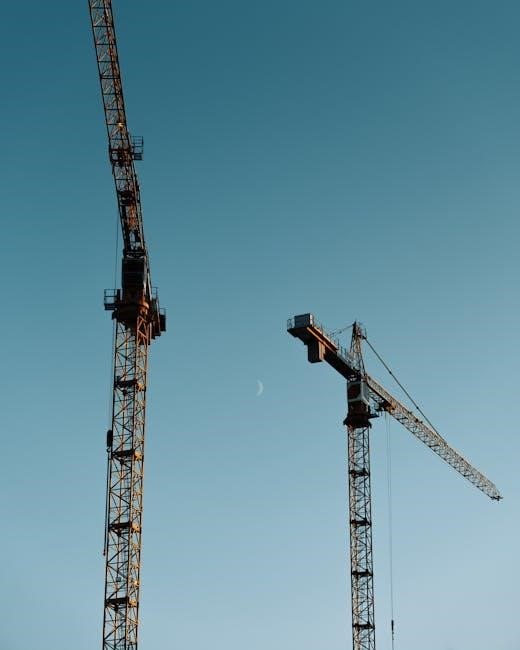
Technical Specifications of JLG Boom Lifts
JLG Boom Lifts offer impressive maximum heights, reach capacities, and load limits, ensuring versatility for various applications. Models like the JLG 1500AJP boast a 150ft reach, while others provide robust weight and load capabilities.
Maximum Height and Reach Capacities
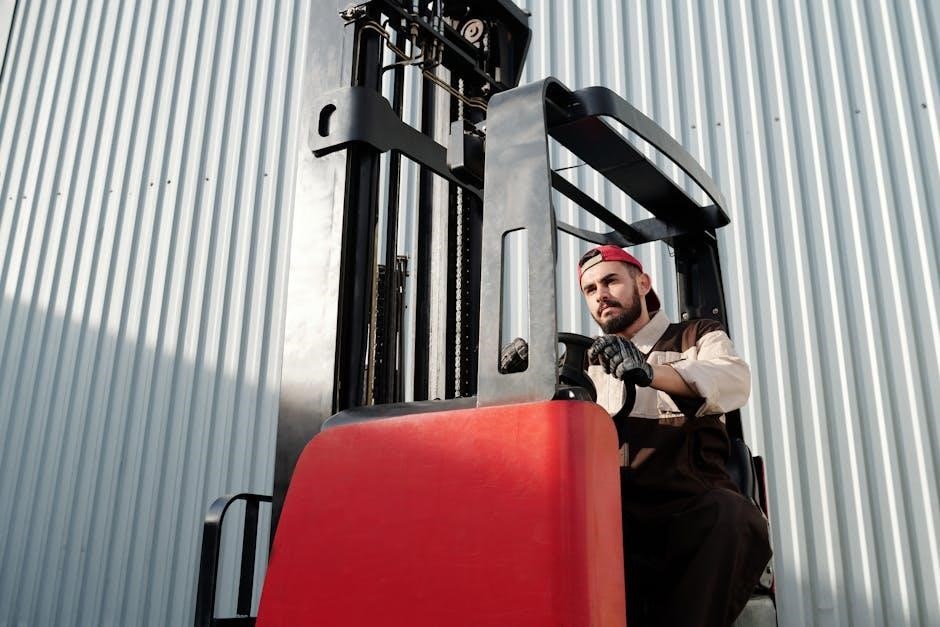
JLG Boom Lifts are designed to deliver exceptional height and reach capabilities, catering to diverse industrial and construction needs. Models like the JLG 1500AJP offer an impressive 150-foot maximum reach, while others provide slightly lower yet equally efficient heights. The 1930ES model, for instance, reaches up to 80 feet, making it ideal for medium-sized projects. These lifts ensure operators can access high areas safely and efficiently. The maximum height and reach capacities are critical for selecting the right equipment for specific tasks, ensuring optimal performance and productivity. Always refer to the operator’s manual for precise specifications, as capacities vary by model and configuration. Proper understanding of these limits ensures safe and effective operation.
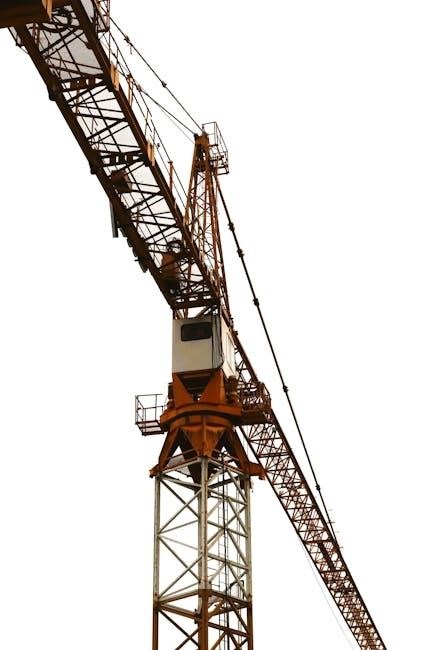
Weight and Load Limits
Understanding and adhering to the weight and load limits of your JLG Boom Lift is crucial for safe and efficient operation. These limits are designed to ensure the machine operates within its design specifications, preventing potential hazards such as instability or equipment damage. The weight limit refers to the maximum allowable weight the lift can support, including the platform, occupants, and any materials or tools. Load limits vary by model, with higher-capacity models like the JLG 1500AJP offering greater load capabilities compared to smaller models such as the 1930ES. Always consult the operator’s manual for specific weight and load specifications, as exceeding these limits can compromise safety and machine performance. Regular inspections and maintenance are essential to ensure the lift remains within its rated capacity. Operators must also consider factors like terrain and machine position, as these can affect the overall load limit. By adhering to these guidelines, operators can ensure safe and reliable operation of their JLG Boom Lift.
Drive Speed and Control Options
The JLG Boom Lift offers versatile drive speed and control options to enhance operational efficiency and precision. Operators can choose between dual-speed functionality, allowing for faster movement across job sites and slower, more precise adjustments when positioning the boom. Variable speed controls enable smooth transitions, reducing jerkiness and improving stability. Some models feature proportional controls, which provide intuitive operation by correlating control input directly to boom movement speed. Additionally, JLG lifts may include features like directional switches and enable switches for added control. These options ensure operators can adapt to different work environments and tasks, from tight spaces requiring slow, deliberate movements to open areas where higher speeds are beneficial. Proper training is essential to master these controls effectively. Always refer to the manual for model-specific details on drive speed and control configurations;
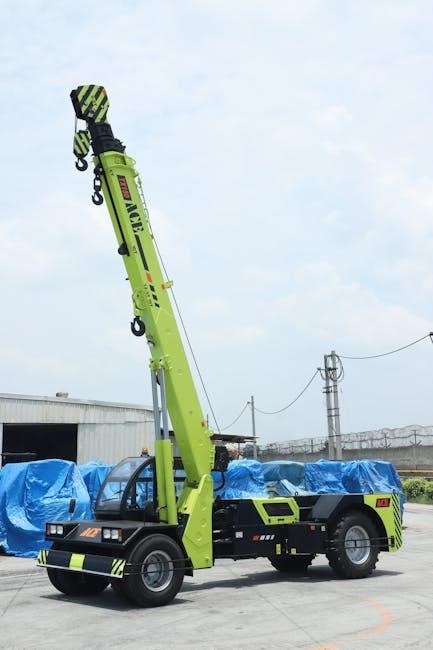
Training and Certification for Operators
Proper training and certification are essential for safe and efficient JLG Boom Lift operation. Operators must complete OSHA-required programs and adhere to renewal processes to ensure competency and compliance.
Required Training Programs
Operators of JLG Boom Lifts must complete OSHA-required training programs to ensure safe and efficient operation. These programs cover essential topics such as safety protocols, operational procedures, and emergency protocols. Training typically includes both theoretical and practical components, ensuring operators understand equipment functionality and safety measures. Hands-on practice is crucial to master boom lift operation, including load management and stability. Regular updates on new regulations or equipment advancements are also included to keep operators informed. Proper training ensures compliance with industry standards and reduces the risk of accidents. By completing these programs, operators gain the necessary skills and knowledge to operate JLG Boom Lifts safely and effectively in various work environments.
Certification Renewal Process
The certification renewal process for JLG Boom Lift operators ensures ongoing compliance with safety standards and operational expertise. Operators must renew their certification every three years, as required by OSHA regulations. The renewal process involves completing a refresher training program, which includes both classroom and hands-on sessions. Key topics covered during renewal training include updated safety protocols, equipment advancements, and operational best practices. Operators must also pass a written exam and demonstrate proficiency in operating the boom lift. Upon successful completion, a new certification is issued, valid for another three-year period. Regular renewal ensures operators stay informed about industry changes and maintain their ability to operate JLG Boom Lifts safely and effectively. Proper documentation and record-keeping are essential for tracking certification status.
Best Practices for Operator Training
Effective operator training is crucial for ensuring the safe and efficient use of JLG Boom Lifts. Training should begin with a comprehensive review of the operator’s manual, emphasizing safety protocols and equipment functionality. Hands-on training is essential, allowing operators to practice maneuvers in a controlled environment; Regular refresher courses should be conducted to reinforce proper techniques and address any updates in equipment or regulations. Supervisors should monitor operator performance and provide constructive feedback. Operators should also be encouraged to ask questions and seek clarification on any procedures they find unclear. Incorporating real-life scenarios into training helps prepare operators for potential challenges on the job. Documentation of training sessions and operator proficiency is recommended for record-keeping purposes. Continuous learning ensures operators remain competent and confident in their abilities.
The JLG Boom Lift Operator’s Manual serves as an indispensable resource for operators, ensuring safe and efficient equipment operation. By adhering to the guidelines outlined, operators can maximize productivity while minimizing risks. The manual is designed for operators and technicians, providing clear instructions for daily inspections, maintenance, and troubleshooting. It emphasizes the importance of following safety protocols and best practices to prevent accidents. Regular updates and adherence to manufacturer recommendations are crucial for optimal performance. Operators should always stay informed about new procedures and regulatory changes. Continuous learning and hands-on experience are key to mastering boom lift operations. Ultimately, this manual is a comprehensive tool that, when followed diligently, ensures the safe and effective use of JLG Boom Lifts, benefiting both the operator and the organization.